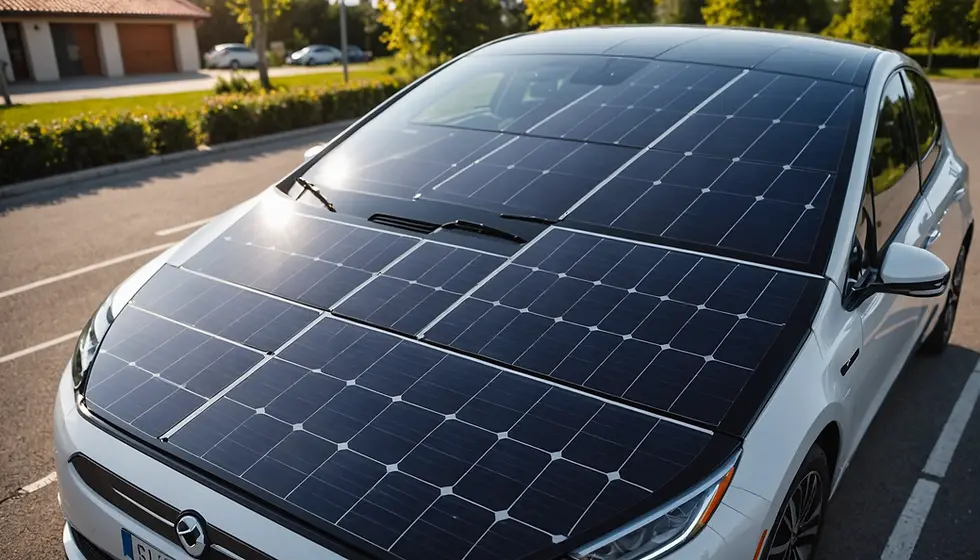Transforming Mobility: The Vision and Goals of the SCEV Initiative
- Menno Drescher

- Sep 4, 2025
- 5 min read
The automotive industry is undergoing a significant transformation. People are increasingly looking for sustainable solutions and innovative technologies. Among the most promising advancements is the Self-Charging Electric Vehicle (SCEV) Initiative, which aims to change how we think about electric mobility. In this blog post, we will explore the strategic vision and goals of the SCEV Initiative, showing its potential to reshape the future of transportation.
1.0 Executive Summary
The Self-Charging Electric Vehicle (SCEV) Initiative is a bold program created to lead the development and market introduction of vehicles that redefine energy independence. The mission of the SCEV Initiative is clear: to eliminate range anxiety and promote sustainable mobility by delivering vehicles that return home with substantial charges and act as dynamic energy assets for the household.
This ambitious goal hinges on a carefully governed portfolio of coordinated projects, each focused on critical technology pillars. These include solar energy harvesting, intelligent battery management, and bidirectional energy transfer (Vehicle-to-Home). For instance, early research suggests that vehicles equipped with efficient solar panels could generate up to 30% of their energy needs from sunlight alone. By implementing industry best practices like a dedicated Program Management Office (PMO), formal phase-gate reviews, and integrated risk management, the SCEV Initiative aims to accelerate innovation.
The initiative's structure is designed to create seamless integration among specialized R&D efforts, manage risks collectively, and encourage collaboration among all stakeholders. The plan outlines the program's phased objectives, the key projects it will launch, and the key performance indicators (KPIs) that will define its progress toward market leadership by 2030. The SCEV Initiative is rooted in core values such as Innovation, Sustainability, Safety, and Collaboration.
2.0 Program Goals by Phase
The main objective of the SCEV Program is to establish a strong leadership position in the self-charging electric vehicle market by 2030. To achieve this, the program will unfold in distinct phases, each with specific goals and milestones.
Phase 1: Research and Development (2025-2027)
The first phase will focus on intensive research and development to investigate technologies that will support the SCEV. This includes advancements in solar energy harvesting, battery technology, and energy management systems. The goal is to create prototypes that effectively demonstrate self-charging capabilities.
In this phase, partnerships with research institutions and technology companies are vital. For example, collaborating with organizations like the National Renewable Energy Laboratory (NREL) can accelerate the development of cutting-edge solutions, ensuring the SCEV Initiative remains at the forefront of technological advancements.
Phase 2: Pilot Programs and Testing (2028-2029)
Once initial prototypes are created, the next phase will involve pilot programs and extensive testing. This will help the SCEV Initiative gather real-world data on vehicle performance, energy efficiency, and user experience. For instance, a successful pilot program could show that vehicles can maintain 90% of their energy capacity over a week without being plugged in. Feedback from these testing phases will be crucial in refining the technology and addressing any challenges.
The main aim of this phase is to confirm the self-charging capabilities of the vehicles and demonstrate their practicality to potential consumers.
Phase 3: Market Launch and Expansion (2030)
The final phase will focus on launching self-charging electric vehicles into the market. By 2030, the initiative aims to present a range of vehicles that showcase energy independence and sustainable mobility benefits.
Marketing strategies will highlight unique features, such as the vehicles' ability to harness solar energy for charging and provide power back to the home. The initiative will also consider partnerships with energy providers, creating a seamless ecosystem for consumers. For instance, integrating with smart home technologies can allow users to schedule energy use efficiently.
3.0 Key Technology Pillars
To achieve its ambitious goals, the SCEV Initiative will prioritize several key technology pillars. Each pillar plays a critical role in the development of self-charging electric vehicles.
3.1 Solar Energy Harvesting
Solar energy harvesting is a cornerstone technology for the SCEV Initiative. Integrating advanced solar panels into vehicles aims to capture renewable energy while parked. This technology not only charges the vehicle but also supports household energy requirements.
Research indicates that improved solar panel efficiency could enable vehicles to produce up to 15% more energy than current models. This will help ensure that vehicles can generate a significant portion of their energy needs from sunlight, making them less reliant on traditional charging stations.
3.2 Intelligent Battery Management
Efficient battery management is crucial for self-charging electric vehicles. The SCEV Initiative will develop intelligent battery systems that optimize charging and discharging cycles. By enhancing battery life and overall performance, these systems will ensure that vehicles are always ready for use while minimizing energy waste.
With the use of advanced algorithms, the system can adapt to driving habits and seasonal changes. For example, if a user frequently drives in the summer, the system can maximize energy harvesting during sunny months, improving overall efficiency.
3.3 Bidirectional Energy Transfer (Vehicle-to-Home)
Bidirectional energy transfer, or Vehicle-to-Home (V2H), allows vehicles to supply power back to the home. This technology transforms the vehicle into an essential energy resource, providing backup power during outages or reducing grid reliance.
The SCEV Initiative will explore the integration of V2H technology into its vehicles, making energy flow seamless between the vehicle and the home. This innovation not only boosts energy independence but also supports a more sustainable energy framework.
4.0 Program Management and Governance
Effective program management and governance are essential for the SCEV Initiative's success. A dedicated Program Management Office (PMO) will oversee the initiative, ensuring efficient project execution and alignment with strategic goals.
4.1 Phase-Gate Reviews
Formal phase-gate reviews will occur at key milestones throughout the program. These assessments will evaluate progress, identify risks, and decide whether projects should advance to the next phase, ensuring efficient resource allocation.
4.2 Integrated Risk Management
Risk management is a core component of the SCEV Initiative. Early identification of possible risks allows for implementing strategies to reduce their impact. This proactive approach increases the likelihood of success and fosters a culture of continual improvement.
5.0 Measuring Success
To evaluate the effectiveness of the SCEV Initiative, key performance indicators (KPIs) will be established. These metrics will provide valuable insights into the program's progress and highlight areas for improvement.
5.1 Market Penetration
Market penetration is a primary KPI. The initiative aims to capture a substantial share of the self-charging electric vehicle market by 2030. For example, setting a goal of achieving 20% market share in the first 5 years post-launch will help focus efforts and resources.
5.2 Customer Satisfaction
Another essential metric is customer satisfaction. The SCEV Initiative will prioritize user experience, ensuring vehicles meet consumer needs. Regular surveys and feedback avenues will be implemented to gather insights and drive continuous improvement.
5.3 Environmental Impact
The environmental impact of the SCEV Initiative will also be tracked. By promoting sustainable mobility and reducing fossil fuel reliance, the program seeks to contribute to a cleaner future. Metrics related to carbon emissions reduction—such as a target of cutting emissions by 40%—will illustrate the initiative's overall impact.
6.0 Future Possibilities
The Self-Charging Electric Vehicle (SCEV) Initiative represents a promising step toward transforming mobility and promoting sustainable energy solutions. By focusing on innovative technologies, effective program management, and customer satisfaction, the initiative aims to secure a leading position in the self-charging electric vehicle market by 2030.
As the automotive industry evolves, the SCEV Initiative is at the forefront of this transformation. It paves the way for a future where electric vehicles serve not only as transportation but also as key contributors to energy independence and sustainability.






Comments